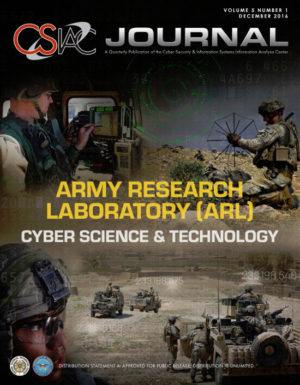an email newsletter released every month highlighting the latest articles, events, technical inquiries, and voices from the community
Winter 2017: Volume 5 Issue 1

Winter 2017: Volume 5 Issue 1
Published: January 26, 2017
Cyber Science & Technology at the Army Research Laboratory (ARL)
U.S. Army Research Laboratory has established a Collaborative Research Alliance, or CRA, which will include an alliance of ARL, U.S. Army Communications-Electronics Research, Development and Engineering Center, academia and industry researchers to explore the basic foundations of cyber science issues in the context of Army networks. ARL cyber research efforts will increasingly focus on developing the models, methods, and understanding to overcome existing barriers to the realization of effective cyber fires and maneuvers in a tactical environment. This journal issue explores those efforts.

